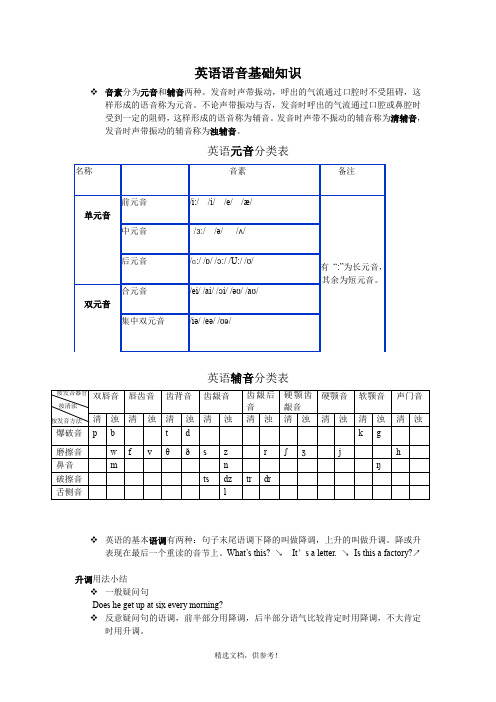Chapter 02 补 英语语音的分类描述
- 格式:ppt
- 大小:607.00 KB
- 文档页数:19



英语国际音标英语共有48个音标,分元音和辅音两大类。
元音有20个;辅音有28个。
一、元音分类元音分单元音和双元音。
根据舌位的变化,元音又可分为前元音、中元音和后元音。
舌位在口腔前部的时候发出的元音叫做前元音,舌位在口腔中部的时候发出的元音叫做中元音,同理,舌位后缩到口腔后部发出的元音就叫做后元音。
元音分类表:是请看以下的三、发音器官发音主要分为三部分:喉部、口腔、鼻腔。
A.喉部的发音器官: 1.气管2.声带(包括声门) 3.会厌软骨B.口腔的发音器官:4.舌:a.舌端 b.舌前部c.舌后部d.舌根5.硬腭 6.软腭 7.上齿龈 8.上下齿 9.上下唇 l0.小舌C.鼻腔四、单元音的发音发音方法描述:发音时舌尖抵住下齿,前舌部向硬腭抬起,嘴唇向两边伸开呈扁平型。
发音时间延续较长。
例词:l ea f树叶 ch ee se奶酪t ea茶 gr ee n l ea ves 绿叶b ea ch海滩 w ee k星期t ea m队 m ea t肉 sh ee p羊d ee p s ea深海发音方法描述:发音时舌尖抵下齿,舌前部向硬腭抬起,比发/i:/时低些,口形扁平,牙床比发例词:发音方法描述:舌身尽量降低并收缩,舌后部抬起。
口张大,双唇收圆,并稍向前突。
发音延续较长。
例词:w al k走路 w ar m暖和的 w a ll墙 f or m表格 fl oor地板l aw法律 blackb oar d黑板 b a ld秃头的 airp or t机场h a ll大厅发音方法描述:舌身尽量降低并后缩,舌后部抬起,口形稍收圆,开口比长元音稍大但不向前突出。
发音短促。
例词:acr o ss越过 b o x盒予 d o g狗 d o lphin海豚d o ctor医生 h o bby嗜好 h o t热的o ff离开o live橄榄 p o p通俗音乐发音方法描述:舌身后缩,舌后部尽量抬起,口形较小较圆,较突出。
发音延长。

英语语音基础知识音素分为元音和辅音两种。
发音时声带振动,呼出的气流通过口腔时不受阻碍,这样形成的语音称为元音。
不论声带振动与否,发音时呼出的气流通过口腔或鼻腔时受到一定的阻碍,这样形成的语音称为辅音。
发音时声带不振动的辅音称为清辅音,发音时声带振动的辅音称为浊辅音。
英语元音分类表英语辅音分类表英语的基本语调有两种:句子末尾语调下降的叫做降调,上升的叫做升调。
降或升表现在最后一个重读的音节上。
What’s this? ↘It’s a letter. ↘Is this a factory?↗升调用法小结一般疑问句Does he get up at six every morning?反意疑问句的语调,前半部分用降调,后半部分语气比较肯定时用降调,不大肯定时用升调。
You are a student, aren’t you? ↘(肯定语气)You went to the park yesterday, didn’t you? ↗(不大肯定语气)选择疑问句or 前面的部分。
Is he a doctor or a nurse?列举事物We study Chinese, English, history, geography, and other subjects.降调小结陈述句We go to school every day.特殊疑问句What does your father do?祈使句Turn on the light, please.选择疑问句的后一部分Do you go to word by bus or by bike?句子重音:在一个句子中,有的词重读,有的词不重读:名词,动词,形容词,副词,数词,指示代词一般都重读; 冠词,介词,连词一般不重读,有少数动词和许多代词也不重读。
`This is an `English `book.`Beijing and `Nanjing are both `very `big `cities.The `pen on the `desk is `mine.I `went to `see `two `doctors `yesterday.句子重读需注意的一些细节1. 祈使句一般用降调。

![英语语音的分类[整理版]](https://img.taocdn.com/s1/m/34767ee39f3143323968011ca300a6c30c22f14c.png)
音素和国际音标01.什么是音素:音素是语音的最小单位。
02.音素的分类:元音和辅音。
03.音素的个数:共48个,元音音素20个,辅0音音素28个。
04.什么是音标:记录音素的符号叫做音标。
05.什么是国际音标:国际音标是由国际语音0协会规定的一套音标,用来0记录世界各主要语言的语音。
07. 开音节:a) 辅音+元音+辅音+e : name, bike, home, due, plane, shine0b) 辅音+元音: he, go, hi, do, be, tree, three, hello08. 闭音节:a) 辅音+元音+辅音: bad, bed, sit, hot, cup,let, mad, map0b)元音+辅音: it,is, of, in, on, up, out, ant09.重读音节:单词中发音特别响亮的音节。
0元音和辅音的定义:0发音时声带振动,呼出的气流通过口腔时不受阻碍,这样形成的语音称为元音。
0不论声带振动与否,发音时呼出的气流通过口腔或鼻腔时受到一定的阻碍,这样形成的语音称为辅音。
0发音时声带不振动的辅音称为清辅音。
0发音声带振动的辅音称为浊辅音。
0元音音标学习0元音概述:元音是有噪音的语音。
形成元音时,声带振动,气流经由咽腔和口腔逸出时,不受到任何阻碍,没有可以听得到的摩擦声。
英语里共有20个元音(单元音12个,双元音8个)。
0元音之间的差异,是由发音时各发音器官所采取的不同位置床的开合程度,以及唇形的大小和圆扁。
但其中决定的因素是舌头的位置:舌头是在口腔的前部、中部或者后部,决定所发的音是前元音、中元音还是后元音;舌身隆形成的。
所谓“不同位置”,指的是舌头的高低与前后,牙起的高度以及舌的哪一部分隆起最高,决定发出的元音是开口元音、半开元音、合口元音、还是半合元音。
牙床开合的程度是由舌位的高低所决定的,而双唇的圆扁和大小对形成不同的元音也有相当的影响。
因此,描述一个元音的发音部位,主要是描述它的舌位和唇形。
Chapter 2 Phonology 音系学1.The phonic medium of language语言的声音媒介Speech and writing are the two media used by natural languages as vehicles for communication. Of the two media of language, speech is more basic than writing. Speech is prior to writing. The writing system of any language is always “invented” by its users to record speech when the need arises.For linguists, the study of sounds is of greater importance than that of writing.The limited ranges of sounds which are meaningful in human communication and are of interest to linguistic studies are the phonic medium of language (语言的声音媒介) . The individual sounds within this range are the speech sounds (语音). 2.What is phonetics?什么是语音学?Phonetics is defined as the study of the phonic medium of language;It is concerned with all the sounds that occur in the world’s languages.语音学研究的对象是语言的声音媒介,即人类语言中使用的全部语音。
Chapter 2 Phonology 音系学1.The phonic medium of language 语言的声音媒介Linguists are not interested in all sounds ;they are concerned with only those sounds that are produced by the human speech organs in so far as they have a role to play in linguistic communication .These sounds are limited in number .This limited range of sounds which are meaningful in human communication and are of interest to linguistic studies are the phonic medium of language ;and the individual sounds within this range are the speech sounds.语言学家也并不是对所有的声音感兴趣,他们只关注那些在语言交际中占有一席之地、由人类的发音器官所发出来的那些声音。
这些声音在数量上是有限的。
这些范围有限,但对人类交际活动意义重大、对语言学研究价值不菲的声音就是语言的声音媒介,凡是在这个范围的每个单个的声音都叫做语音。
2.Phonetics 语音学2.1What is phonetics? 什么是语音学?language; it is concerned with all the sound that occur in the world’s languages.上所有的语言中出现过的一切声音。
These three branches of phonetics are labeled articulatory phonetics, auditory phonetics, and acoustic phonetics respectively.语音学的三个分支分别被称为发音语音学,听觉语音学和声学语音学。